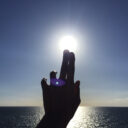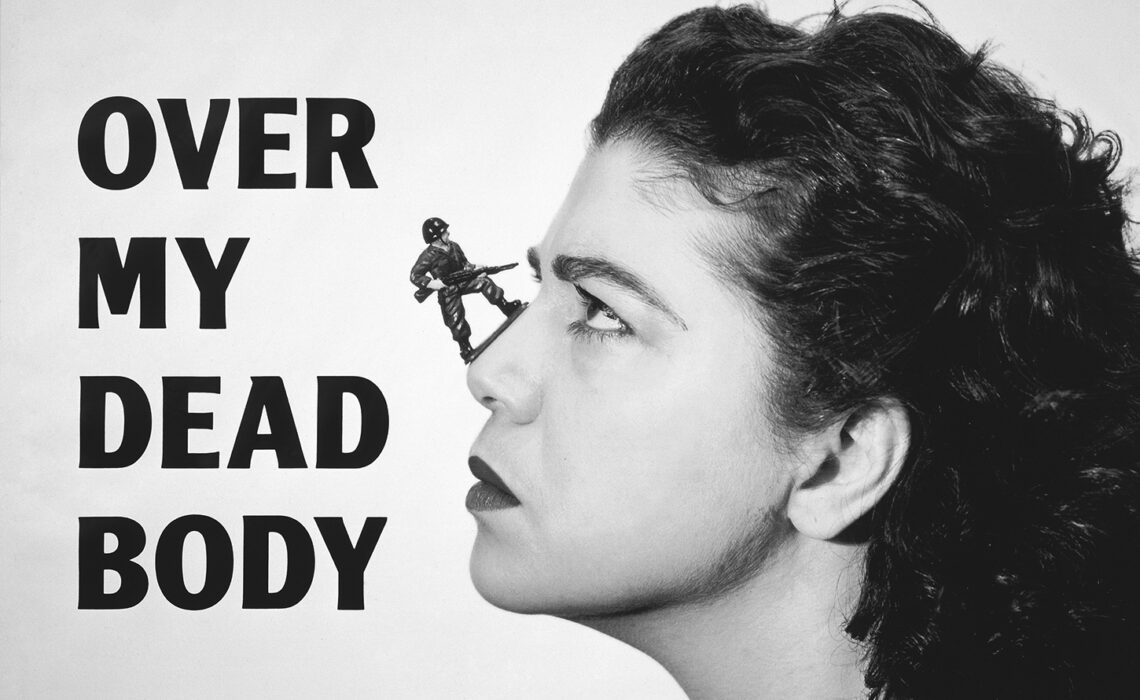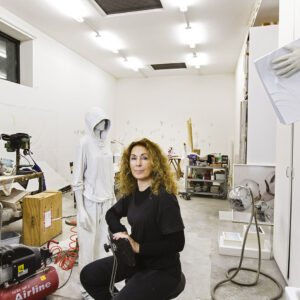Mona Hatoum è un’artista anglo-palestinese, nata a Beirut, in Libano, nel 1952, dove la sua famiglia di origine palestinese, originaria di Haifa, fu esiliata all’inizio del conflitto arabo-israeliano, nel 1948.
Nel 1975, partita per una breve visita a Londra, si trova costretta a rimanere in Inghilterra a causa dello scoppio della guerra civile in Libano. Da quest’esperienza deriva un sentimento di dislocazione che si manifesterà poi nei suoi lavori futuri. A Londra frequenta la Byam Shaw School of Art e la Slade School of Fine Art (University College, Londra) tra il 1975 e il 1981.
È lei stessa ad ammettere che uno dei primi aspetti che l’hanno colpita in Inghilterra è stato il costante monitoraggio della società, con strumenti di sorveglianza e di controllo, da parte dello Stato. Coinvolta anche in gruppi femministi, da subito, quindi, si è interessata alle dinamiche di potere e alle tematiche di genere, di razza e di classe. Attraverso la lettura, tra gli altri, di Foucault e Bataille, si è molto interessata al “Panopticon” di Bentham, al tema della sorveglianza, ai vari meccanismi di controllo statale, ai rapporti tra Occidente e Terzo mondo.
La sua formazione scolastica è avvenuta a Beirut, una città da lei definita cosmopolita, prima in una scuola francese, poi italiana e infine in un’università americana, studiando grafica e poi lavorando per un breve periodo per un’agenzia pubblicitaria. Come è tipico di varie regioni arabe e nordafricane postcoloniali, il Libano ha un’importante dimensione multiculturale che produce un senso di identità molto complesso.
Le sue origini, la sua esperienza londinese e, negli ultimi anni, il tempo trascorso tra Londra e Berlino, le hanno regalato un’esperienza culturale eterogenea e un’esistenza multiforme, come poi emergerà nella diversità formale e nei molteplici approcci propri delle sue opere, nonché nella loro dimensione politica, mediante indagini e riflessioni sul significato fisico e morale delle frontiere, dell’esclusione, dei conflitti politici, delle diseguaglianze globali.
Grater Divide (2002) è per esempio un paravento la cui forma richiama una grattugia gigante da cucina. Si tratta della costruzione di una barriera fisica in metallo, minacciosa da una parte e familiare dall’altra, sospesa in una dimensione insieme di pericolo e di calore domestico. Cambiare la scala di un oggetto significa cambiarne l’essenza, creare spaesamento, porsi dei quesiti su ciò che ci circonda quotidianamente.
Più volte gli oggetti domestici e quotidiani – come sedie, letti, culle e utensili da cucina – sono stati modificati, reinterpretati e trasformati in strutture intimidatorie e oscure. Lo stesso ha fatto nel 1994 con la videoinstallazione Corps étranger, in cui ha filmato l’interno del suo corpo con un endoscopio che penetrava nel suo apparato digerente: caverne oscure, palpitazioni, maree mai viste. Il dentro, nascosto, chiuso ermeticamente, se portato fuori, spaventa.
Nel 2009 realizza invece Hot Spot III, un grande globo dall’inclinazione assiale terrestre, fatto di acciaio come fosse una gabbia, con dei neon rossi che definiscono i contorni dei continenti. Illuminandosi, i confini prendono fuoco, tremano attraverso il neon che li surriscalda e il titolo, in italiano “Zona calda”, sta proprio a indicare una dimensione di guerra e conflitto globale, non quindi localizzata in peculiari regioni del mondo. Hatoum ci invita a riflettere su quanto ogni parte della terra sia coinvolta in una diffusa dimensione di conflitto, percepito o latente, generalizzato o rivolto a singole cerchie della popolazione.
Projection (2006) è invece un lavoro su carta, in cotone e abaca, in cui viene incisa, bianco su bianco, la mappa della terra, seguendo la Proiezione di Gall-Peters, che si differenzia dalle consuete cartine geografiche perché presenta la reale estensione delle terre, in contrasto con la proiezione distorta di Mercatore. Lo spettatore si trova di fronte, dunque, ad una proporzione reale della massa terrestre, in una prospettiva egualitaria e non condizionata da politiche e culture dominanti.
La sua produzione si divide in due periodi. Il primo, negli anni Ottanta, vede la realizzazione di performance in cui l’artista promuoveva un confronto diretto con il pubblico, in cui la dimensione politica era già importante e spesso riferita alla situazione della sua terra originaria.
Dagli anni Novanta ha invece cominciato a realizzare sculture, installazioni e ambienti in cui è il corpo dello spettatore al centro della scena e non più quello dell’artista.
Importante è anche la sua chiave di rilettura del minimalismo. In quest’ottica si inserisce, tra le altre, l’opera Socle du Monde (1992-1993), chiara rilettura dell’omonima opera di Piero Manzoni contaminata dalle influenze di Eva Hesse. Le rigide e sterili forme del minimalismo vengono smosse da una superficie tortuosa che richiama i ripiegamenti intestinali dell’apparato digerente o i lobi del cervello, ottenuta attraverso un’anima magnetica che attira la limatura di ferro disponendola in maniera organica.
Sempre in questa direzione sono opere come Light Sentence (1992), Cage-à-deux (2002), Cube (2006), Cube (9 x 9 x 9) (2008), Turbulence (black) (2014), Map (clear) (2015), A Pile of Bricks (2019), Inside Out (2019), in cui le classiche forme di griglie, cubi, sfere, e gli aspetti di serialità e ripetizione si trasformano in qualcosa di macabro, pauroso. Il cubo diventa una prigione; il parallelepipedo è infatti una gigantografia di una gabbia per canarini, una gabbia a misura d’uomo; la sfera si increspa attraverso forme che richiamano le interiora del corpo; la luce, invece di porre chiarezza, destabilizza lo spazio; l’immagine del mondo rappresentata attraverso l’unione di biglie diventa un terreno scivoloso, impraticabile, mortale.
Le grandi installazioni create a partire dagli anni ’90, inoltre, hanno un costante riferimento all’architettura, alle strutture di potere occidentali, alle modalità in cui queste vengono assorbite dalla psiche delle persone e espresse attraverso i nostri comportamenti, le decisioni prese, ecc.
Per questo, un altro aspetto delle sue installazioni è proprio quello di creare una forte sintonia tra spettatore e spazio, così che siano anche più immediate e sentite le sensazioni di minaccia, instabilità, sorpresa che tante sue opere infondono. Questo è esacerbato dalla creazione di lavori che rimandano ad atmosfere o oggetti domestici – Untitled (wheelchair II), 1999; Interior Landscape, 2008; No way IV, 2013; Electrified (variable II), 2014; Remains (chair) I, 2017; Quarters, 2017; Remains (cabinet), 2019 – e che quindi instaurano subito un rapporto di confidenza e abitudine con lo spettatore, ma che poi siamo portati a mettere in discussione. Disorientamento ed estraniamento nascono dalla lettura delle sue opere, per frantumare l’abitudine, interrompere il consueto, porci questioni e mettere in discussione le conoscenze acquisite.
Mona Hatoum ha partecipato a numerose importanti mostre collettive tra cui la Biennale di Venezia (1995 e 2005), Documenta, Kassel (2002 e 2017), la Biennale di Sydney (2006), la Biennale di Istanbul (1995 e 2011) e la Biennale di Arte Contemporanea di Mosca (2013).
Le mostre personali recenti includono un’importante retrospettiva organizzata dal Centre Pompidou, Parigi (2015), in seguito presentata alla Tate Modern di Londra e al KIASMA di Helsinki (2016) e poi negli Stati Uniti alla Menil Collection di Houston (2017) e alla Pulitzer Arts Foundation di St. Louis (2018).
La Hatoum ha ricevuto il Joan Miró Prize (2011), il 10° Hiroshima Art Prize (2017) e il Praemium Imperiale (2019). È l’attuale vincitrice del Premio Julio González 2020, Institut Valencià d’Art Modern (IVAM), dove il prossimo anno si terrà una sua personale.
The World Trembles
Mona Hatoum is a British-Palestinian artist, born in Beirut, Lebanon in 1952, where her Palestinian family who come originally from Haifa, was exiled at the beginning of the Arab-Israeli conflict in 1948. While on a short visit to London in 1975 the outbreak of the Lebanese Civil War prevented Hatoum from returning to Beirut. She decided to stay in UK and has lived in London ever since. From this experience comes a feeling of dislocation that will later manifest itself in some of her work. In London she attends the Byam Shaw School of Art and the Slade School of Fine Arts (University College, London) between 1975 and 1981.
She herself admits that one of the first things that struck her of England, was the constant monitoring of society through instruments of surveillance and control by the State. She was also involved in women’s groups, which lead her to examining power dynamics along the lines of gender, race and class. Through reading, among others, Foucault and Bataille, she became very interested in the concept of the “Panopticon” of Jeremy Bentham, in the subject of surveillance, in the various mechanisms of state control and in the relationship between the West and the “Third World”.
Her school education took place in Beirut, a city she defines as cosmopolitan. She first attended a French school, then an Italian one and finally an American university, studying graphic design and then working for a brief time in an advertising agency. As it is typical of the post-colonial condition in the Arab and North African region, Lebanon has many different cultural influences that produce a richly complex sense of identity.
Her origins, her experience of living in London and more recently, dividing her time between London and Berlin, has given her a heterogeneous cultural experience and a multifaceted existence, as would later emerge in the formal diversity and in the multiple approaches typical of her work, as well as in their political dimension, through investigations and reflections on the physical and moral significance of borders, exclusion, political conflicts, global inequalities.
Grater Divide (2002) is, for example, a screen whose shape recalls a giant kitchen grater. It is the construction of a physical metal barrier, menacing on one side and familiar on the other, suspended in a dimension of both danger and domestic warmth. Altering the scale of an object means changing its essence, creating disorientation, making us question our daily surroundings. Often domestic, everyday objects – such as chairs, beds, cribs and kitchen utensils – are modified, reinterpreted and transformed into threatening, dark structures. She created a similar effect in 1994 with the video installation Corps étranger, where she filmed the inside of her body with an endoscope that penetrated inside her digestive system: dark caves, palpitations, tides never seen before. The inside which is usually hidden, hermetically sealed, is frightening when made visible.
In 2009 she realizes Hot Spot III, a large globe which tilts at the same axis as the earth, made of steel rods and looking like a cage, with red neon strips defining the outlines of the continents. When illuminated, the borders catch fire, the work buzzes with an intense energy. The title implies that spots of conflict are not localized in specific regions of the world but are a global occurrence. Hatoum invites us to reflect on how much every part of the world is involved in a shared dimension of conflict, perceived or latent, generalized or aimed at specific sections of the population.
Projection (2006) is a white on white work on paper that uses cotton and abaca to create a recessed image of the map of the world, following the Gall-Peters projection, which differs from the usual maps because it features the land masses in true proportion as opposed to the distorted Mercator projection. So, the observer is presented with a world map where the continents are in correct proportion to each other, a more egalitarian perspective, not conditioned by dominant politics and cultures.
Her production can be divided into two periods. During the 1980s, Hatoum created performances in which she used direct confrontation with the audience, where the political dimension was already important, and often touched on the situation of her homeland.
From the 1990s onwards she began creating sculpture, installations and environments in which the body of the spectator is at the centre of the scene and no longer that of the artist. Much important is also her reinterpretation of minimalism. In this perspective we can find, among other works, Socle du Monde (1992-1993), a clear reinterpretation of the work with the same title by Pietro Manzoni, contaminated by the influences of Eva Hesse. The strict and sterile forms of minimalism are disturbed by an undulating surface which recalls the intestinal folds of the digestive system or the lobes of the brain, created by means of a cluster of magnets covered in iron filings, organising them in an organic pattern.
Also following this direction are works such as Light Sentence (1992), Cage-à-deux (2002), Cube (2006), Cube (9 x 9 x 9) (2008), Turbulence (black) (2014), Map (clear) (2015), A Pile of Bricks (2019), Inside Out (2019), in which the classic shapes of grids, cubes, spheres, and aspects of seriality and repetition are transformed into something more macabre and frightening. The cube becomes a prison; the parallelepiped is in fact a blown-up canary cage, a human-sized cage; the sphere ripples with forms that recall the innards of the body; light, instead of bringing clarity, destabilizes space; the picture of the world represented through the use of marbles becomes a slippery, impassable, deadly ground. Moreover, the large installations created since the early 1990s, feature a constant reference to architecture, to the Western structures of power, to the ways in which they are absorbed by the collective psyche and expressed through our behaviour, the choices we make, etc.
For this reason, another aspect of her installations is precisely that of creating a strong harmony between audience and space, so that the feelings of threat, instability and surprise that many of her works convey can be more immediate. This is exacerbated by the creations of works referencing domestic atmosphere or objects – Untitled (wheelchair II), 1999; Interior Landscape, 2008; No Way IV, 2013; Electrified (variable II), 2014; Remains (chair) I, 2017; Quarters, 2017; Remains (cabinet), 2019 – and that immediately establish a relationship of trust and habit with the viewer, a relationship that, however, we are later inclined to question. Disorientation and estrangement arise from the interpretation of her works, to break the habits, interrupt the customary, ask questions and challenge acquired knowledge.
Hatoum has participated in numerous important group exhibitions including the Venice Biennale (1995 and 2005), Documenta, Kassel (2002 and 2017), Biennale of Sydney (2006), Istanbul Biennial (1995 and 2011) and Moscow Biennale of Contemporary Art (2013).
Recent solo exhibitions include a major survey organised by Centre Pompidou, Paris (2015) that toured to Tate Modern, London and KIASMA, Helsinki (2016) and a US tour at Menil Collection, Houston (2017) and Pulitzer Arts Foundation, St Louis (2018).
Hatoum was awarded the Joan Miró Prize (2011), the 10th Hiroshima Art Prize (2017) and the Praemium Imperiale (2019). She is the current recipient of the 2020 Julio González Prize, Institut Valencià d’Art Modern (IVAM), where a solo exhibition of her work will be held next year.








No Comments